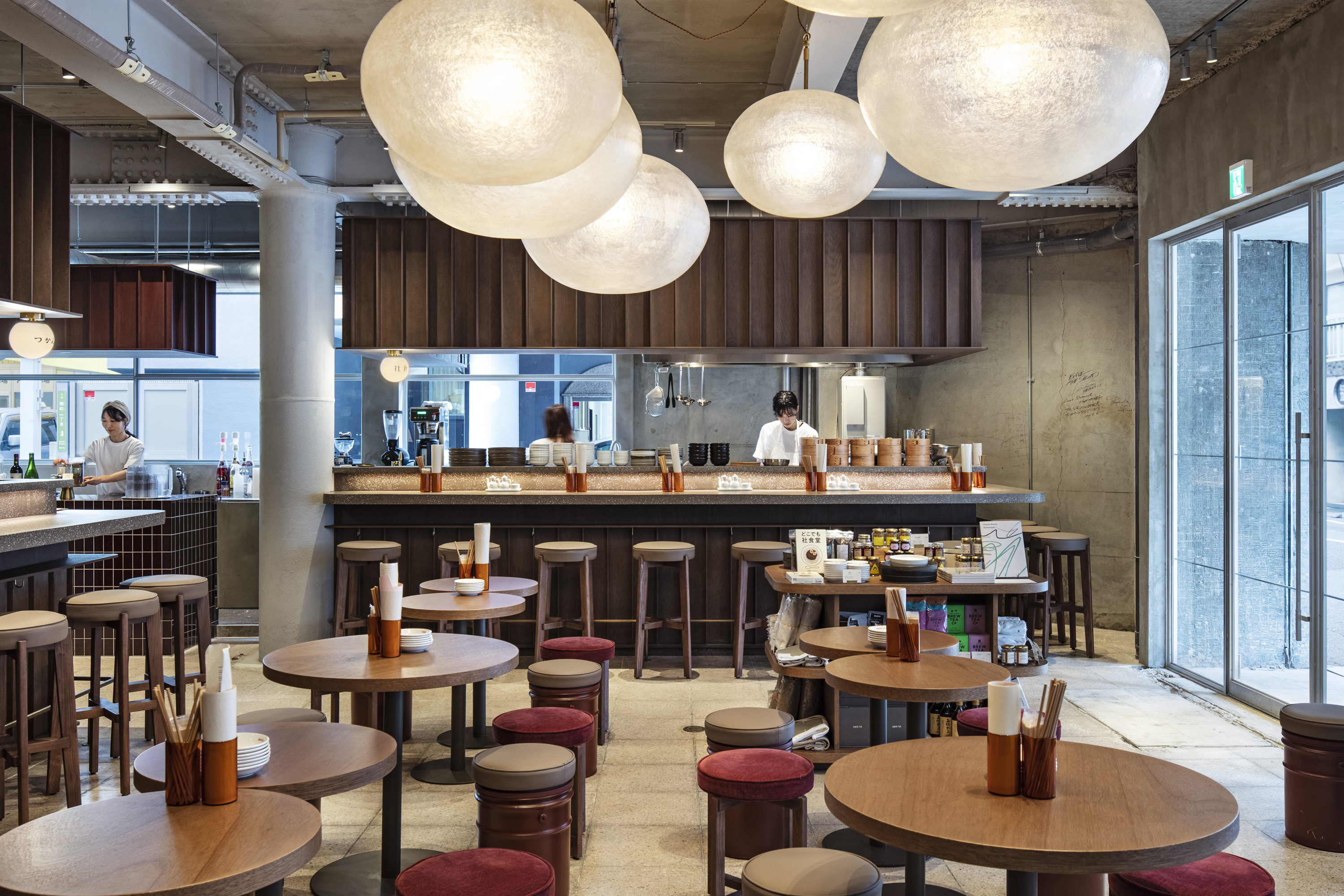
Nekoyacho Bldg. is a multi-layered renovation of an old office building on a quiet lane in Hiroshima city, recently completed by Japanese studio Suppose Design Office. A handful of its striking architectural ingredients? A metal-coated façade of deep textured orange. A sauna with cut-out openings framing skies. Spice lemon and chai flavoured ice creams. Raw concrete staircases with colour-tinted windows. And a plant-filled design studio.

Nekoyacho Bldg: an 'experimental playground'
'Eat, work and rejuvenate' is the philosophy behind Nekoyacho Bldg., which Suppose Design Office describes as an experimental playground – a space for exploring their own design ideas with a rare purity, while creating a sense of both culture and community.
Located near the Peace Memorial Park, the building is home to a mix of restaurants, galleries, event spaces, a sauna and a rooftop terrace, alongside their new design studio – threaded together by a raw-edged renovation that strips off decades of decorative layers to reveal the industrial essence of its original form.

For Suppose Design Office, the project is something of a homecoming: the studio was originally founded in Hiroshima in 2000 by Ai Yoshida and Makoto Tanijiri, both hailing from the region, although its main hub has been in Tokyo for the past 15 years.
After purchasing the five-storey Hiroshima building a few years ago, Yoshida realised that their ideal work environment was more like a 'playground' than an office. 'As designers by profession, we believe that an office that keeps us mentally and physically healthy and creative at all times is a place where we can really get excited and nurture our own ideas and creativity. With this in mind, we began planning an office and commercial facility, aiming for a place that is a crossroads of 'food, work, and entertainment' with a good mix of Hiroshima and Tokyo cultures.'

The unique angular façade tells its own story. The original tiles of the 50-year-old corner building were stripped off, leaving behind the unexpected grid-like imprints of their former presence, which was then preserved in a metal coating – creating a deeply textured and rust-like surface atmosphere.
Emphasising a desire for the design to reflect an 'acceptance' of the building’s unique qualities, Yoshida adds: 'Architecture can be compared to mixed martial art, and renovation is akin to aikido. We wanted to take over the relationship between the building and the city and renew it into a new place by 'accepting and utilising' the individuality of the building, such as inflexible structure and an excess design.'

The buzzy ground floor is home to four restaurants with open communal-style seating. Suppose reinterpreted the materials and forms of the original structure to create new spaces – from benches fashioned from existing window frames to a clutch of hovering organic balls of light suspended from the ceiling made from original FPR.
Among the restaurants is Shashokudo, a canteen 'for staff and society' which already exists in Suppose’s Tokyo studio, serving an array of healthy all-day dining meals; Tsukanto, specialising in new wave tonkatsu and natural wines; Sibire, a charcoal barbecue eatery; and Yacone, creators of craft ice cream in original flavours.

The sweeping lines of an original staircase, stripped back to its raw concrete bones, sit to the left of the ground floor, its bottom step removed and replaced with the organic form of a single boulder stone, hinting at the threshold of a traditional space such as tearoom.
The stairs flow into a first floor open-plan concrete-walled gallery and events space; while a rear staircase, equally raw in its material renovation, with vintage windows in coloured glass on the landing, rise to the second floor where Suppose Design Office’s new Hiroshima studio is based, with co-working spaces.

Inside is a warm mesh of woods, concrete and plants in an earthy-toned palette. A long Lauan wood table is lined with the arced lines of ten Naoto Fukasawa-designed Maruni chairs, above which floats a long glass tube pendant light, while exotic ferns burst from an interior garden and another wall is lined with integrated bookcases.
One floor up is vacant office space (transformed into an atmospheric contemporary ikebana exhibition during Wallpaper*s visit); while the top floor is home to Hiki stargazing sauna.

Here, a contemporary sauna is wrapped in clean-lined wood, overlooking a plant-packed internal garden – known as a 'tsuboniwa' in traditional Japanese architecture – with cut out openings framing views of the skies. And at the apex is a rooftop terrace, a lush urban escape packed with fruit trees, plants and herb, from biwa and rosemary to olives.
For Suppose, Nekoyacho Bldg. may be open but it’s far from finished: instead, it’s designed as a project that will continue to grow and adapt through its uses and interactions with the community.

As Yoshida says: 'We tried creating the spaces we wanted to create and the architecture that impresses us. We would like to explore our own unique way of working and a new way of being a design firm through this kind of challenge.'
'Nekoyacho Bldg. is a playground made together with the people and city and a place for our ever-changing spatial experiments.'







